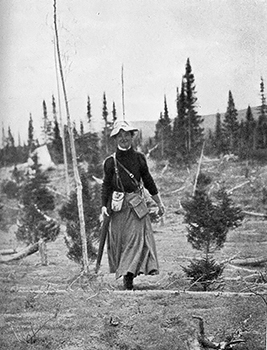Mina Benson Hubbard Ellis National Historic Person (1870-1956)

© Hubbard, Mrs. Leonidas, Jr., 1908. A Woman’s Way Through Unknown Labrador. London, John Murray, facing p. 88 [henceforth A Woman’s Way]
At the turn of the 20th century, explorer, surveyor, and exploration writer Mina Hubbard led an expedition to survey the last unmapped area of eastern Canada. Her daring 1905 expedition through unexplored eastern Labrador resulted in notable advancements in geographical knowledge. Taking continuous measurements of latitude along the 900 kilometre journey from North West River to Ungava Bay, Hubbard established the correct positions of the Naskaupi and George Rivers and associated lakes and tributaries. The map she produced was immediately recognised by both the American and British Geographical Society and remained definitive until the advent of aerial photography in Labrador in the 1930s.
Mina Benson Hubbard Ellis was born in 1870 on a farm in Ontario. She worked as a teacher from 1886 to 1896 before training as a nurse in New York. One of her patients there was Leonidas Hubbard, Jr., a former teacher turned journalist. They married in 1901, but two years later he died of starvation and exposure while exploring Labrador. In 1905, Mina Hubbard set out to finish her husband’s work and led an expedition through the interior of northeastern Labrador. She travelled with four skilled woodsmen and also brought cameras, meteorological instruments, and survey equipment. Though she was neither an experienced wilderness traveller nor a geographer, her well-planned expedition was completed in record time and she compiled a valuable set of observations. Hubbard’s photographs represented the first such record of the interior landscape and its people, the Innu. Her map of the region’s rivers and lakes, published in 1906, was the basis for official maps of North America for decades.
Hubbard was also an author of a classic of Canadian exploration literature. Her 1908 publication A Woman’s Way Through Unknown Labrador and her field diary are unique departures from standard exploration writing of the day. Instead of focusing on themes of endurance and contest, her written work reveals an openness to the perspectives and opinions of her Indigenous and Métis four-man crew. This ensured that their values and sensitivities, rather than European paradigms, determined the comfortable nature of the trip and its success. The earliest Canadian woman to launch and complete an expedition with explicitly scientific goals, Hubbard was recognized for her scientific contributions and made a Fellow of Britain’s Royal Geographical Society in 1927.
The National Program of Historical Commemoration relies on the participation of Canadians in the identification of places, events and persons of national historic significance. Any member of the public can nominate a topic for consideration by the Historic Sites and Monuments Board of Canada.
- Date modified :